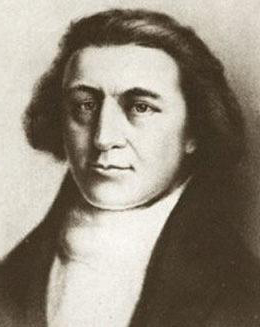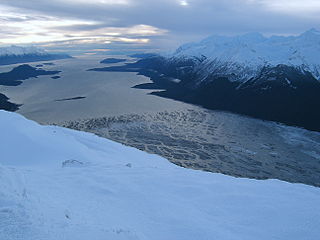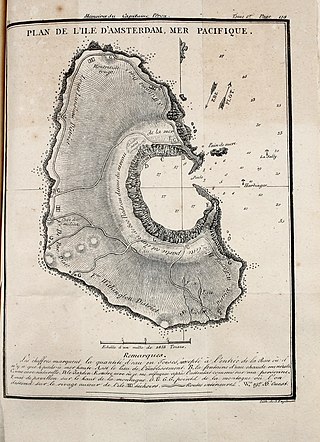Related Research Articles

Robert Gray was an American Merchant Sea Captain who is known for his achievements in connection with two trading voyages to the northern Pacific coast of North America, between 1790 and 1793, which pioneered the American maritime fur trade in that region. In the course of those voyages, Gray explored portions of that coast and in the year 1790 he completed the first American circumnavigation of the world. He was also noted for coming upon and naming the Columbia River, in 1792, while on his second voyage.

Chilkat Inlet is an inlet in Lynn Canal in the Southeast region of the U.S. state of Alaska that includes the delta for the Chilkat River and borders Haines and the Chilkat Peninsula. It was first charted in 1794 by Joseph Whidbey, master of HMS Discovery during George Vancouver's 1791–1795 expedition.

Adventure was built by the crew of Captain Robert Gray on his second voyage in the maritime fur trade to the Northwest Coast of North America. The 45-ton sloop was built to allow the trading venture to access smaller inlets the Columbia could not reach. At the end of his second voyage Gray sold the ship to the Spanish Navy. It was renamed Orcacitas and served the Naval Department of San Blas for some years.

Joseph Ingraham (1762–1800) was an American sailor and maritime fur trader who discovered several islands of the Marquesas Islands while on his way to trade along the west coast of North America. He was also a prisoner in the American Revolutionary War and an officer in the United States Navy.
Resolution was a small American schooner, built in the Marquesas Islands in 1793 as a tender for the maritime fur trade ship Jefferson. Later in 1793 she arrived at the Columbia River, becoming the fourth European vessel to enter the river. Cruised between the Columbia River and Clayoquot Sound. In March 1794, Resolution separated from Jefferson. After several brief voyages she was captured and destroyed by Haida chief Cumshewa and his followers in 1794. All the crew but one were killed. The lone survivor was later rescued by the Boston ship Despatch.
James Colnett was an officer of the British Royal Navy, an explorer, and a maritime fur trader. He served under James Cook during Cook's second voyage of exploration. Later he led two private trading expeditions that involved collecting sea otter pelts in the Pacific Northwest of North America and selling them in Canton, China, where the British East India Company maintained a trading post. Wintering in the recently discovered Hawaiian Islands was a key component of the new trade system. Colnett is remembered largely for his involvement in the Nootka Crisis of 1789—initially a dispute between British traders and the Spanish Navy over the use of Nootka Sound on Vancouver Island that became an international crisis that led Britain and Spain to the brink of war before being peacefully resolved through diplomacy and the signing of the Nootka Conventions.

Before the 1849 California Gold Rush, American, English and Russian fur hunters were drawn to Spanish California in a California Fur Rush, to exploit its enormous fur resources. Before 1825, these Europeans were drawn to the northern and central California coast to harvest prodigious quantities of southern sea otter and fur seals, and then to the San Francisco Bay Area and Sacramento – San Joaquin River Delta to harvest beaver, river otter, marten, fisher, mink, gray fox, weasel, and harbor seal. It was California's early fur trade, more than any other single factor, that opened up the West, and the San Francisco Bay Area in particular, to world trade.

The maritime fur-trade, a ship-based fur-trade system, focused largely on acquiring furs of sea otters and other animals from the indigenous peoples of the Pacific Northwest Coast and natives of Alaska. Entrepreneurs also exploited fur-bearing skins from the wider Pacific and from the Southern Ocean.
Simon Metcalfe was a British-born American surveyor and one of the first American maritime fur traders to visit the Pacific Northwest coast.
Otter was a maritime fur trading vessel. Between 1795 and 1798 it visited the Pacific. It was most famous for the rescue of Thomas Muir, a famous Scottish political exile.

French Captain Pierre François Péron, born in 1769 at Lambézellec, near Brest, was a French sailor and trading captain who sailed to many different locations in the late 18th century. He owned his ship until it was captured by the British, following which he became a sealer and adventurer.

The Butterworth Squadron was a British commercial group of three vessels, Butterworth, Jackal, and Prince Lee Boo, that sailed for the Pacific Ocean from London via Cape Horn in late 1791. The principals financing the expedition were Alderman William Curtis, London ship-owner Theophilus Pritzler, and probably John Perry, a Blackwall shipbuilder. The leader of the expedition was Captain William Brown, an established whaling captain from the Greenland whale fishery. Sigismund Bacstrom, a naturalist who had previously sailed as a secretary to Sir Joseph Banks, was the surgeon for the expedition. Bacstrom produced a number of drawings during the first part of the voyage, some of which are still in existence.

Duff was a ship launched on the Thames in 1794. In 1796 the London Missionary Society engaged her to take a party of missionaries to the South Pacific. Once she had landed the missionaries she sailed to China and took a cargo back to England for the British East India Company. On this voyage her captain named a variety of South Pacific islands. On her second voyage to deliver missionaries a French privateer captured her in 1799 off the coast of Brazil on the outward-bound leg of her voyage.
Thomas Humphrey Metcalfe was an American maritime fur trader who worked with his father, Simon Metcalfe. After being separated from his father in a storm, Thomas sailed a small schooner with a crew of four from the vicinity of China to Nootka Sound on Vancouver Island where he was arrested by the Spanish. After being released he sailed to Hawaii, hoping to find his father. Instead, he was attacked and killed by Native Hawaiians in revenge for misdeeds committed by his father just days before.
Jenny was built at Newfoundland in 1783. She sailed to Britain and traded between Britain and Newfoundland and then between Bristol and Africa until 1790 when Sydenham Teast purchased her. Between 1791 and 1794 she made two voyages exploring the Pacific Northwest and gathering sea otter pelts. In 1796 she returned to trading with Africa but was lost in January 1797 as she was returning to Bristol from Africa.
Union was an American sloop built in Somerset, Massachusetts in 1792. It is best known for its circumnavigation of the world, 1794–1796, under the maritime fur trader John Boit.
Hope was an American brigantine built at Kittery, Maine in 1789 for use in the maritime fur trade and owned by Thomas Handasyd Perkins, Russell Sturgis, and James Magee.
James Magee (1750–1801) was one of the first Americans involved in the Old China Trade and the Maritime Fur Trade. He was born in County Down, Ireland, probably near Downpatrick. James and his brother Bernard immigrated to New England shortly before the American Revolutionary War Described as a "convivial, noble–hearted Irishman", he married Margaret Elliot, sister of Thomas Handasyd Perkins, in October 1783. Magee lived in Roxbury, today part of Boston, ultimately in the Shirley–Eustis House, which he bought in 1798. His brother, Bernard Magee, was also a sea captain in the maritime fur trade.
Margaret was an American ship built at Boston and launched in the fall of 1791. It was built for use in the maritime fur trade and was owned by Thomas Handasyd Perkins, Russell Sturgis, James and Thomas Lamb, and James Magee. It was armed with eight cannon and six to eight swivel guns. On its maiden voyage it left Boston with a crew of 25.
References
- ↑ Howay, F. W. "A Yankee Trader on the Northwest Coast, 1791-1795." Washington Historical Quarterly 21, No. 2 (1930), pp. 83-94.
- ↑ Ogden, Adele. The California Sea Otter Trade, 1784-1848. Berkeley: University of California Press. 1941, p. 157
- ↑ Mardsen, William. The History of Sumatra. 3 ed. London: J. M'Creery, 1811.
- ↑ report in The Oriental Star (Calcutta) carried in The General Evening Post (London), 11 January 1794.

